Consumption of ICTs, including audiovisual ones, has increased due to COVID-19. The different media, entertainment and conversation with friends have been widely disseminated, especially online and in a remarkable way among youth. Since the outbreak of the pandemic, the evolution of these consumptions will determine the function of each medium, the reliability of the information or the place occupied by the Basque country.
1. Introduction
The article “Pandemic antivirus and changes in online (Basque) behaviors in the media ecosystem” highlights that the effects of COVID-19 are important in the use of information and communication technologies (ICT) and in the social functions they perform (Mimenza, Narbaiza and Arana, 20201). At the toughest time of the closure, in the spring of 2020, and for a long period thereafter, the new trends that have emerged in the area of communication and consolidation of existing ones have been remarkable. We will mention two to begin with. On the one hand, living in a hyperconnected society and the consumption of information was increased by the coronavirus, especially in digital media. On the other hand, with the new social routines, audiovisual content predominated, mainly entertainment, occupying leisure time.
When the pandemic broke out, digitalisation and media convergence stood in the middle of the communication scene. The socialization and diffusion of the use of these technologies were then strengthened in the public, private, personal and labor spheres.
As already mentioned, these technologies, resources and supports that channel information, communication and entertainment have spread, especially in the last period, and accelerated by the pandemic. It is very interesting to analyze what we use them for and, therefore, what social functions they perform or where, how long and what content they guide. In fact, despite global trends, local peculiarities (social, political or linguistic, for example) need to be addressed. In our case, we have also taken into account how young people take on board the technologies and functionalities mentioned.
The Ikusiker Panel was launched in the spring of 2019 and thanks to the collaboration of its 800 students, it is possible to learn how young people from public universities in the South Basque Country (UPV/EHU and UPNA) internalize and use ICTs. The advent of the pandemic and the months after it are an important reference for quantifying changes in the communication landscape. The monthly questionnaires sent to respondents in the Panelkides provide information on how consumption changes and how they adapt to current conditions. Surveys are generated on the platform www.pollestafacil.com and the sending and management of data is the responsibility of the research institute Aztiker. Around this research project, called Applika+, EITB, Tabakalera, the Basque Observatory of Culture and, as mentioned, members of the NOR research group of the UPV/EHU meet. The road results are available at www.ikusiker.eus
This article will use data from 2020 and 2021, among others, to describe the situation and, in some cases, to establish comparisons between the two years.
2. Attention to information and communication technologies during confinement
The confinement led people to spend more time at home collecting information, enjoying entertainment content and collaborating in videoconferences with friends/colleagues/colleagues/fellow students. Set ahead of the traditional media until then more usual, people decided at the beginning of the appearance of COVID-19 by social networks, digital payment platforms and web pages. That is why we will analyze in this article the scope of social networks and the time these platforms have acquired. And it"s that communicating with friends and seeing serial fictions had and have a huge attraction between respondents in the Ikusiker Panel. In addition, we will discuss how television has lived the whirlpool of the coronavirus. And, in the last part, we will refer to the place that the contents in Basque occupy in the broad audiovisual panorama.
2.1 Desire for information, entertainment and communication
In March 2020, since local and local governments set up an alarm situation on the occasion of COVID-19, people"s movements were limited and confined. Two of the consequences of the anomalous situation were staying at home and having to adapt the daily time to another use. In this way, there was a general and rapid socialization of the technological supports of work, study, leisure and communication. The resources of information and communication technologies (ICT), as well as university students, became, almost once and for all, a daily reality. The answers obtained to the questions asked to the students of the UPV/EHU and the UPNA that make up the Ikusiker Panel show the size of the changes after the coronavirus explosion.
The questionnaires in the spring of 2020 showed that students (93.1%) clearly identified that they used ICTs — be they social networks, digital platforms, traditional media or video games — rather than before the outbreak of the pandemic. Overall, the use of these technologies by university students was higher (35.6%) than usual (57.5%).
At the time of confinement, therefore, the dedication to communication, entertainment and information increased. The students" answers show the daily time devoted to social networks, applications, on-demand platforms, web pages and conventional television. The figure below shows that the scope of these five resources, the most important, became very large and, for example, social networks became widespread — even ahead of television. The image also shows that social networks occupied large spaces of time in the daily routines of more than 800 students from the university panel of Hego Euskal Herria.
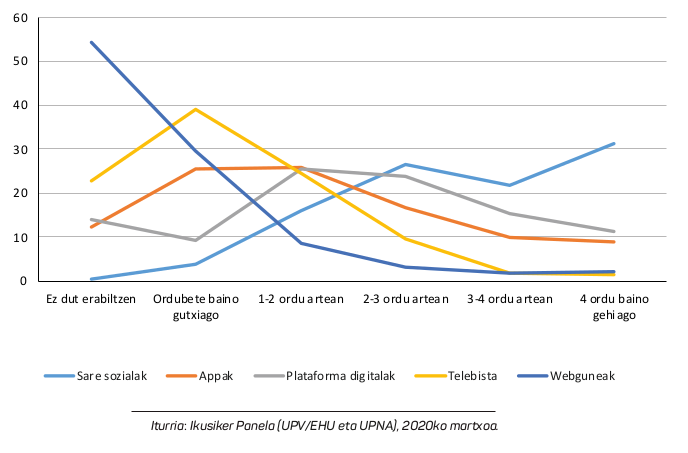
It is noteworthy the degree of integration of social networks in the lives of these young, almost universal, and the long time they dedicated each day. Social networks reached 99.6% of youth and 79.5% sailed for more than two hours a day. For the most enthusiastic consumers (31.4%), one in three spent four or more hours connected to social networks. Digital platforms like Netflix, HBO or Amazon Prime were also a success among Panelkides, and half of young people were routinely placed their daily consumption between 1 and 3 hours in the early months of the pandemic. In contrast, the most frequent use of linear television was one to two hours, according to the participants in the questionnaire.
The consumption of traditional and online media increased at the beginning of the pandemic, and the respondents clearly indicated the main social functions they performed: to inform, to entertain and to communicate. Social networks (91.6% of students), television (76.7%) and web pages (73.8%) were the most used in accessing information. The responses of the Panelkides also show that university students between the ages of 18 and 23 were connected for a long time in order to receive information about the coronavirus. People who, despite being very numerous, claim to be less than an hour on social media (47.7%) are similar to those who work more than an hour daily (43.9%). As for traditional television, three out of four students came to her for information, with a margin of 60 minutes or at most two hours, with 44% and 24.5% respectively. Finally, as mentioned above, web pages (73.8%), both newspapers and official bodies, were also used for information purposes. But their temporary dedication was lower than that of social media and television. The one-hour investment time was 45.6% of the students and from one to two hours, 15.4%. The number of Panelkidas who spent the most time exploring the Internet was 13%.
Within the confinement, in order to entertain, the contents preferred by the students of the UPV/EHU and UPNA are fiction. The series is the most successful format among university students. 88.9% reported seeing La Casa de Papel, The Big Bang Theory, Gossip Girl or Toy Boy. The number of people who dedicated 1-2 or 2-3 hours daily to see the catalogue of series chosen by the platforms was 32.3% and 24.7%, respectively. Conversely, the attraction of films was more limited, as almost a quarter of the university population (23.5%) claims not to consume it. In any case, it can be said that most of the students who saw films were in the consumption intervals of one hour and three hours, where 51.9% of the students were concentrated. The consumption time of the cosmic videos was even shorter: 40.2% in the option of less than an hour and 21.1% between 1 and 2 hours. It is also noteworthy that the percentage of students who did not consume this type of content was 28%.
Finally, this section discusses the degree to which this extraordinary context adapted the students" communicative habits. To do this, the time spent using ICT resources by telephone with friends and online was measured. 27.4% of youth were in the two- to three-hour tranche. Those between one and two hours represented 24.6%. More than half of the students (52%) reported having online communication from one to three hours throughout the day. Programs such as Skype, Whatsapp, Zoom, Jitsi or others were used for video calls, and some students spent more than three hours a day talking to their friends (40.1%). Among them, 27.7% were connected between three and five hours and 12.4% between five and more hours.
2.2 Dominance of social networks
As evidenced in the first subsection, the pandemic generalized the spread of ICTs to a greater number of people and increased the time spent on different resources. On this occasion we will focus on social networks. In fact, it is especially interesting to analyze the time spent and the use that students make of the Whatsapp, Instagram, Youtube, Twitter and more recent platforms of Tik Tok and Twitch. To this end, the results of the 2020 and 2021 surveys will be detailed.
First, members of the panel composed of students from the public universities of Hego Euskal Herria are asked to define which social networks they most use. According to the results of the previous surveys, the most cited are Whatsapp, Instagram, Youtube and Twitter, as shown in the figure below.
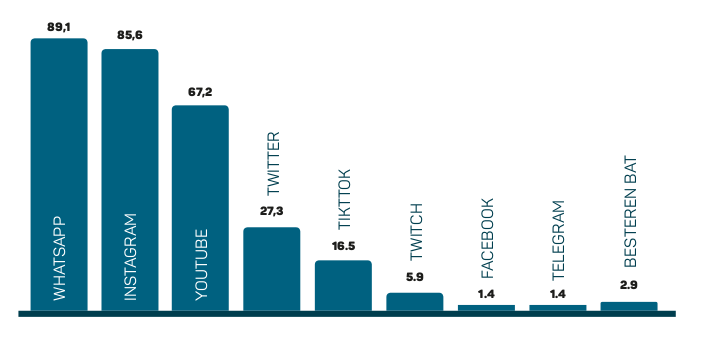
The Ikusiker students, to designate three of the most common social networks, highlight Whatsapp (89.1%) and Instagram (85.6%) and two of every three, besides, list Youtube (67.2%). Twitter, Tik Tok and Twitch are lagging behind and Facebook and Telegram are lagging behind. However, these students usually use more than one social network to perform different social functions, as we shall see later.
The daily time devoted to the most widespread social networks among the students of the panel is not slow either. According to data from March 2020, during the outbreak of the pandemic, the universal use of social media among youth was 79.5% of respondents for two or more hours. More accurately, 26.6% sailed between two and three hours, 21.7% between three and four hours and 31.2% for more than four hours.
After this overview, it is convenient to know a little more the attraction of the different social networks, observing the time dedication of each one of them. As seen in the figure below, Whatsapp and Youtube consumptions of up to one hour are the most common, while Instagram is used between 1 and 2 hours. Twitter dominates fast consumption at intervals of up to fifteen minutes a day. On the other hand, the scope and length of time held by Tik Tok and Facebook are very small, as one remains an emerging social network and the second continues to descend in this age group.
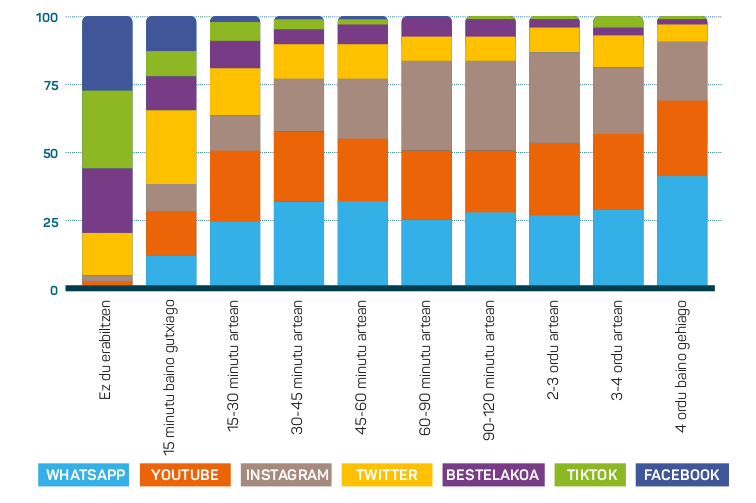
As we have seen, each social network has its particularity in terms of consumption. In addition to time, we will have to find out the reasons for their use. Asking young people from the Ikusiker Panel what social media use for, they point out three functions: relating to friends and acquaintances, spending time and receiving information. To a lesser extent there are other ideas like watching comic content, sharing videos, shopping or meeting new people.
Of the three prevailing tasks, the most outstanding is to communicate with friends. 52% of students use "often" social networks for this purpose and the other 33.8% "always". Thus, the desire to network or maintain interpersonal relationships reaches 85.8% of the gang members. Likewise, 80% of respondents consider social networks as tools of entertainment, of which 55.7% are considered “often” and the remaining 24.3% is used “always” for this purpose. In order to search for information, the number of people heading to Twitter, Youtube or Instagram is lower, with a 53.3% increase (“always” or “many times”), but only increases the percentage of “sometimes” (33.2%).
2.3 Scope of digital platforms that have been expanded
As mentioned above, resources that are part of all ICTs and, among them, those intended for the visualization of fictitious contents, whether series, films, sketches or humorous pieces, are also common in leisure.
Among the students who make up the UPV/EHU panel and the UPNA, the subscription to streaming services like Netflix and Amazon Prime Video is widespread. Moreover, there are not few who have access to payment content. As shown in the figure below, the number of students using this type of VoD service at the beginning of the confinement was high.

A questionnaire immediately after their inclusion in the quarantine revealed that the contents that were most extensive among the students in the panel were series. 88.9% of students were active spectators (76% for films, 72% for ridiculous videos and 63.2% for music).
Asking the Panelkides how long they spent each day watching the series, the answers predominated between one and two and three hours. That is, one third of the students (32.3%) devoted between one and two hours to the series they liked, and another 24.7% between two and three hours. Among the most well-known series is La Casa de Papel, but also the series Elite, Sex Education, Merlí, Friends, Modern Family, Stranger Things and Vis a Vis (Panel Ikusiker, February 2021).
2.4 Place of television in the new ecosystem
As we have anticipated in the introduction of this article, the confinement reorganized the audiovisual consumption of young people before disrupting it. That is, it strengthened some existing trends (centrality of online media and predominance of entertainment content) and others adapted to the new ecosystem (differentiating each media according to the social function assigned to it).
Even when we started the first measurements of the Ikusiker Panel in the spring of 2019, it was clear that television had lost power in the audiovisual consumption of young people. In half the number of people began to dispense with the scheduled broadcast media (in October 2019 we monitored consumption all week and 51% of the panel participants said they had not seen television in those seven days). Therefore, by then other content that they wanted to receive through other media began to prevail.
As we are analyzing the role and place of the different media in the daily life of university students, it is worth noting the importance given to the information offered from television. In response to the question two years ago, 15% of Panelkides said they did not see Teleberri and the remaining 41% saw it only once or twice a week. At the other end, there was the group of respondents who were barely quoted as watching television news, with 4%.
A year later, immersed in the coronavirus crisis, young people were also driven by concerns and lack of information caused by the pandemic. This phenomenon occurred worldwide and in all age groups, so television consumption reached historical levels. Reaching young people in March 2020, 77.1% of Panelkides turned to television for information on COVID-19. Although the number of people who spent less than an hour was 44%, they also exceeded the large screen one and two hours (24.5%) and two and three hours (5%). In that spring of 2020, daily consumption of information above three hours of television represented 4.1%.
At the end of that year, we relaunched some questions about the news items on television and the dedication of time. The answers are shown in the following figure.
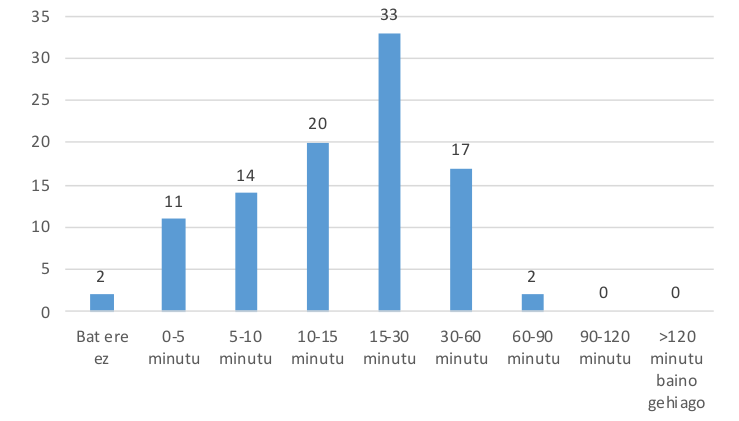
Therefore, it can be said that the attention that television recovered in the period of confinement was more frequent than in time. That is, it was common for college students to see the informative, but these visits are usually quite short (one in three from 15 to 30 minutes and 45% less than 15 minutes).
2.5 Pandemic, time devoted to television and reliability of information
In this subsection we will continue to talk about the incidence of confinement in the audiovisual consumption of university students and, in particular, in the informative use of television. We will start by analyzing the time spent on television and then look at the reliability of the information received from television. Firstly, we will focus our attention on the evolution of the time spent in front of the television screen. To do so, we will compare the first, the first, the first alarm situation (March 2020) and the second, one year later.
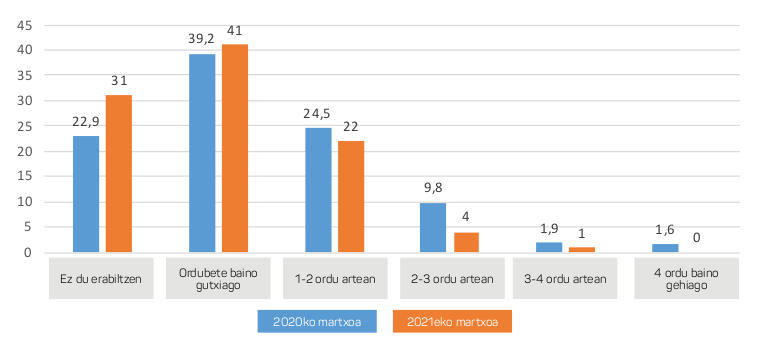
As can be seen in the image, the attraction to television has decreased by ten points in one year. Almost a third of Panelkides don"t watch television. In addition, the time devoted to television has been slightly reduced. Short consumption predominates, less than an hour. Visits of 60-120 minutes are around 20% and those over two hours fall from 13.3% to 5%.
Twelve months after we were shocked by COVID-19, we’ve asked the panel’s students what media they think are most reliable for information about the pandemic. Figure 7 shows that, before and now, regular television channels and the websites of the written and official media are the most reliable. The truthfulness of social media, so used for other functions, is not the same level, the perception about the reliability of the information about the coronavirus they spread is very low.
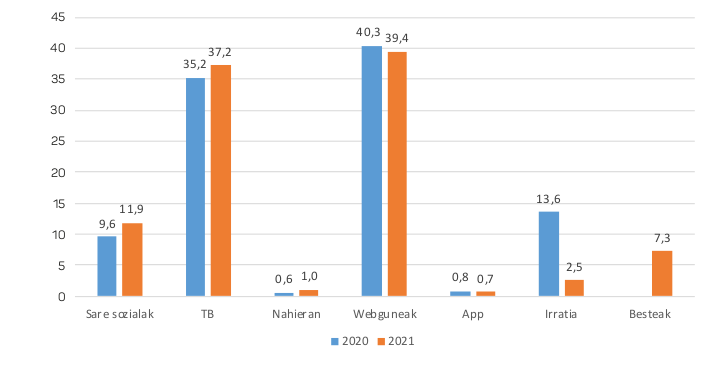
Understanding that television news consumption may be linked to interest in news about COVID-19, when the year the coronavirus turned our day to day, he asks the students in the panel about the importance of the pandemic. As can be seen in the following Figure 8, on a scale from zero to ten the average score is 7.4, but 57.6% considers that it deserves a score higher than 8.
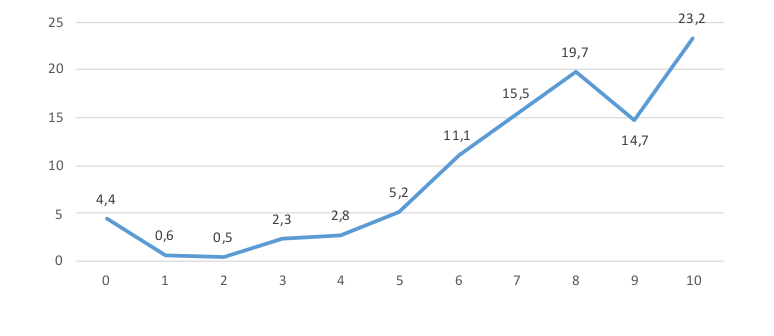
2.6 Place of different languages in the audiovisual diets of young people
Data from the Ikusiker Panel show that university students" Basque knowledge is high: 77% are able to speak, read and write in Basque on average. Now, when asked how much the Basque people use in their daily lives, the answers show a clear commitment to Spanish. As can be seen in the figure below, if the number of people who use only Spanish (26%) and Spanish is increased more than Euskera (45%), it is observed that Euskera is in a weaker position in the students" linguistic behaviors.
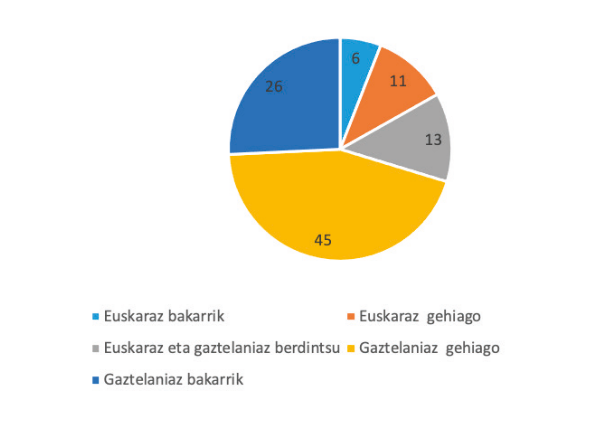
The use of the word has many loopholes and, of course, the audiovisual is one of them. Spanish also dominates audiovisual consumption, which also happens in online media, social networks and traditional media. As an example, when asking the members of the panel what the last contents they have seen, whether fictitious, entertainment or informative, the Spanish language prevails. The following table shows the weakness of the Basque Country, which stands out in these contents, organized according to these three genres.

Spanish predominates in the three genres, but the figures obtained in information and entertainment are especially striking. In the case of fiction, English gets 30.7% and almost 20% in entertainment. The weight of the Basque Country is very low in the recent audiovisual products observed to which paneldists refer. The Basque country obtains 16.8% of the information, but in the rest the presence of products in Basque is practically insignificant.
The great supply of ICTs in languages other than Basque plays an important role in the consumption of university students in the panel, but there are two other factors that can be considered. The first relates to the customs and the limited space that audiovisual production in Basque has so far had in the daily life of young people. The second is the poor promotion and social visibility received by audiovisual products in Basque which have increased in the last season.
3. Short
In the panorama of media communication caused by the pandemic, the observed changes and trends are frequent, of which we highlight seven.
- The coronavirus has greatly influenced the spread of ICTs and the dedication of time among the members of the university gang, standing ahead of the traditional media, and placing special emphasis on social networks — to spend time, entertain, watch fiction, inform and communicate with friends, colleagues or family members.
- Each of the social networks has its own weight and function, according to which it takes more or less time in the daily life of the university students who make up the panel. In any case, the universality of social networks among young people is indisputable.
- In the audiovisual consumption of the youth of the panel, fiction occupies an important place. The most selected contents are the series. The series are seen on both computer and mobile, and 57% of the panelids spend between 1 and 3 hours a day. It"s already well defined that digital fictional visualization platforms are the most common juvenile space, especially Netflix and Amazon Prime Video.
- With the generalization of online platforms and digital media, the media ecosystem has been readapted and the characterization and social function of each media/support has been redefined. Thus, fiction is consumed more in VoD platforms, television is more used for current content and events or events, and the function of social networks is to facilitate communication among young people and maintain links. The time devoted to each of these social functions is different and depends on many factors: new customs, streaks, social and media events, new social demands, etc.
- Since the coronavirus pulled the door and entered our daily lives, media consumption has changed. In any case, the students of the panel, when they want information, maintain the centrality of traditional media, especially television pages and newspapers. Because COVID-19 is still talking.
- In leisure, in the consumption of audiovisual products and especially in fiction, the Basque country occupies a very small place.
- Over and above the adaptations of the moment, it seems that some of the habits and trends we are seeing in the era of the pandemic in the field of communication have come for a long time.
This article is part of the work of the NOR Research Group (IT881-16) of the UPV/EHU (UPV/EHU, EITB, Tabakalera and Basque Observatory of Culture; US20/21) and Solidary (CSO2017-82903-R).
1.- Bulletin BAT No 116, p. 67-103


